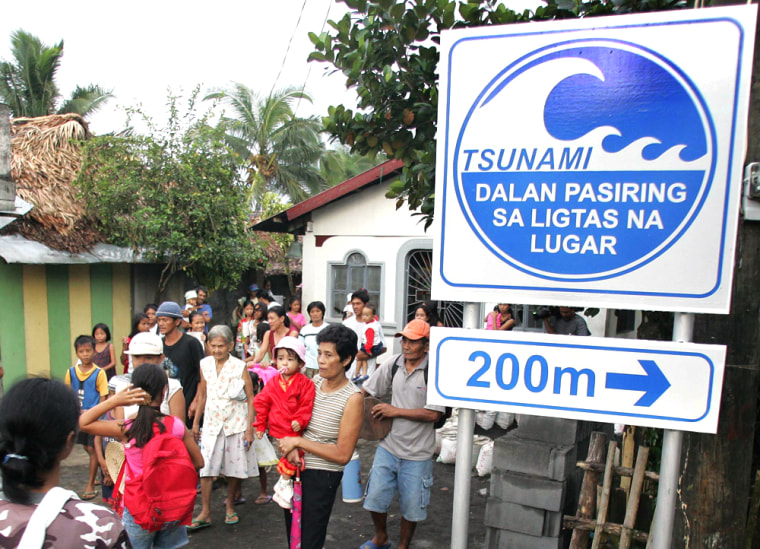Dozens of Pacific Rim nations joined the first widespread test of a tsunami warning system since killer waves in the Indian Ocean claimed more than 200,000 people. During the drill, earthquakes continued to shake the geologically unstable region.
As the Pacific Tsunami Warning Center in Ewa Beach sent out bulletins warning of fictitious waves to more than 30 countries, participating governments tested how fast they receive the warnings and how rapidly they went through domestic emergency alert systems. Few reported problems, although Thai officials said the drill revealed a crucial communication failure in their emergency plan.
Tuesday’s drill was the first extensive test of the warning system, in place since 1965, since the 2004 Asian tsunami that left at least 216,000 people dead or missing and prompted international demands for improvement.
Some areas also conducted mock evacuations, including the coastal village of Buhatan in the Philippines, where nearly 1,000 residents streamed out of their homes, tugging children and struggling to carry bamboo mats, hammocks, coffee pots and roosters.
Several real earthquakes hit Indonesia, Tonga and New Zealand during the exercise. The largest, centered about 710 miles (1,130 kilometers) northeast of Auckland, New Zealand, generated a minor local tsunami that did not affect any populated areas, New Zealand national civil defense controller Mike O’Leary said. It did not affect the drill.
A magnitude-5.8 earthquake rattled Tonga as emergency authorities were broadcasting the simulated earthquake alerts. The National Disaster Office was “bombarded with questions” as the quake hit in the midst of the tsunami test, deputy director Mali’u Takai said.
At the Pacific Tsunami Warning Center, the test began with a beeping sound signaling a mock magnitude 9.2 earthquake off the coast of Chile. Within 10 minutes, test warnings went out from the Hawaii facility, as well as the Alaska Tsunami Warning Center near Anchorage.
It was the first of nine bulletins issued throughout the day, warning of a fictitious wave that grew to as big as 30 feet. Tsunamis generally travel at the speed of a commercial jet, but the center increased the speed four times, for the drill to finish in six hours.
The drill revealed communication problems in Thailand, where the National Disaster Warning Center was supposed to inform its five executive directors of the alert by SMS messaging before informing other officials, including the prime minister and provincial governors.
But the SMS messages failed to reach the five directors or were delayed for hours, said Dr. Cherdsak Virapat, the center’s chief for International Coordination. He said other weaknesses involved dependence on telephones, and greater use of two-way radios was needed for tasks such as following the progress of evacuations.
In Melbourne, Australia, Chris Ryan of the National Meteorological and Oceanographic Centre said that except for some wrong numbers and the real earthquakes, “it all seems to have gone as planned.”
Emergency responders in Hawaii tested their ability Tuesday to deal with an unlikely scenario: a category four hurricane and a 30-foot tsunami approaching the islands at the same time.
“Theoretically, it’s possible that you could have two disasters at the same time,” state Civil Defense spokesman Ray Lovell said. “We might as well see how well we can handle this.”
The Indian Ocean tsunami in December 2004 prompted improvements in the Pacific warning system. Other countries, including Indonesia and nations in the Caribbean, are now spending millions of dollars to establish their own warning centers modeled after the Hawaii facility.
Prior to the Asian disaster, worldwide interest in tsunami warnings had waned.
“So this was a golden opportunity to try and bring that level of preparedness back up,” said Charles McCreery, director of the warning center.
